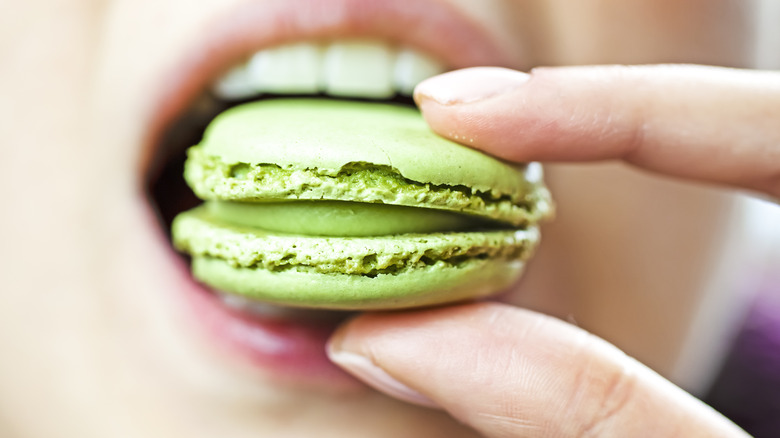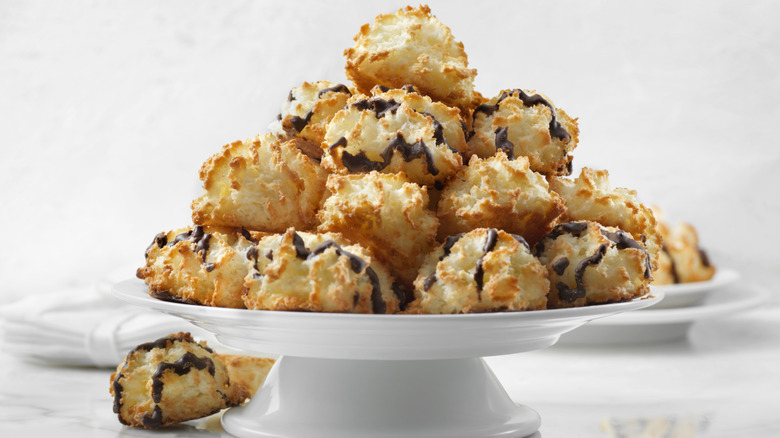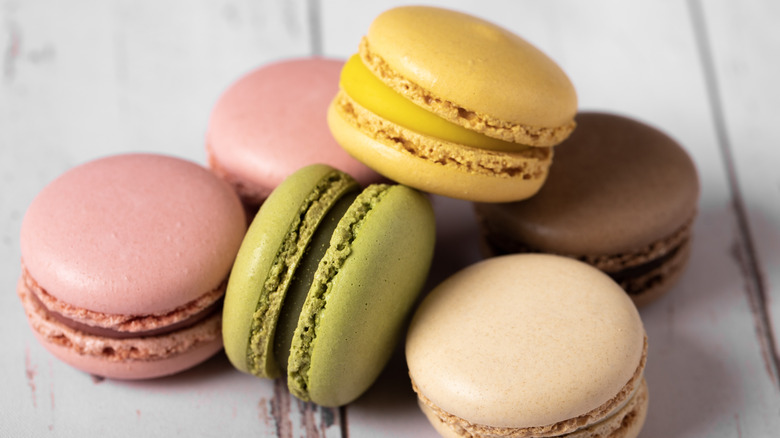Macaron Vs Macaroon: What Makes These Sweet Treats Different?
The first macaroon I ever had was from a little bakery on Catalina Island, which sits about 29 miles off the coast of Long Beach in Southern California. It was about the circumference of a kiwi — a fruit you shouldn't ignore at the grocery store – and it looked like a mound of golden brown, toasted coconut shreds. Half of it was dipped in rich dark chocolate. That soft, fluffy, sweet interior with a touch of almond flavor is a taste I'll never forget. For the rest of my week-long vacation on that lovely island, I had a macaroon every night.
Years later, a co-worker returned from a trip to Paris and brought a pastel-colored box to the office emblazoned with the word "Ladurée" in gold lettering. Ladurée is a celebrated French confectioner famed for its stunning sweets, especially one particular type. Inside the box were several delicate looking sandwich cookies, which I later learned were called macarons. I was confused about the name because it seemed so similar to "macaroon" — but the two couldn't have been more different. Each French macaron (pronounced "mak-ah-rohn") contained two delicate cookies made with almond flour sandwiching an intensely-flavored filling, from pistachio to rose to raspberry.
Despite their very different appearance, structure, and taste, macaroons and macarons do have a few interesting similarities. For one, they each have roots in Italy, and they share a few ingredients. They are also certainly both worth enjoying, at any opportunity you get.
What is a macaroon?
Of the two cookies, macaroons are arguably easier to make than macarons. They are made with egg whites, sugar, shredded coconut, and sometimes (but not always) ground, blanched almonds. The ingredients are combined, dropped in mounds on baking sheets, and baked just until golden brown.
Many food historians believe macaroons originated in an Italian monastery in the 8th or 9th century. The name likely was taken from the Italian word "maccherone" which means "paste." The paste in question was probably almond paste, as macaroons were originally made with ground almonds, not coconut. They transitioned to being coconut-based in the late 19th century when it was discovered that coconut traveled better than nuts without spoiling.
Overtime, macaroons became favored by the Jewish community during Passover because they don't contain flour, an ingredient forbidden during the seven- or eight-day holiday. Today, macaroons are enjoyed year-round by anyone with a sweet tooth, or who has an affinity for coconut. They can be dipped in chocolate, or studded with chocolate chips or dried fruit. The texture is incredibly chewy and satisfying, and they are quite sweet. You can counteract the sugar with a strong cup of tea, coffee, or espresso from your favorite coffee chain.
What is a macaron?
These elegant little cookies can be tricky to prepare, with the temperature and humidity level of your kitchen being capable of making or breaking a batch of the finicky treats. But when they're done right, macarons are absolutely wonderful.
Although macarons are largely considered a French specialty, they, too, have roots in Italy. It is believed that they were created by the pastry chefs of Catherine de Medici in the mid-16th century when she traveled from Italy to France for her marriage to King Henry II. With this theory, macarons could very well have first been made in France. They were likely made with almond flour, egg whites, and sugar but were probably different from the macarons we know today. Modern macarons (with flavorful fillings) were, indeed, created in Paris, by the aforementioned Ladurée.
Successful macarons have a thin, crisp shell that cracks with minimal pressure. The inside of the cookie is chewy and almond-y — the ingredients have largely stayed the same over time, unlike macaroons. Macaron fillings can take several forms including jam, caramel, buttercream, and ganache — an easily-made chocolate indulgence. The cookies are famous for coming in nearly every color and flavor you can think of. The particular flavor of any given macaron generally comes from the filling, rather than the outer shell. If you really want to have some fun, get yourself some coconut macarons; you'll have the flavor of a macaroon in the form of a macaron.


